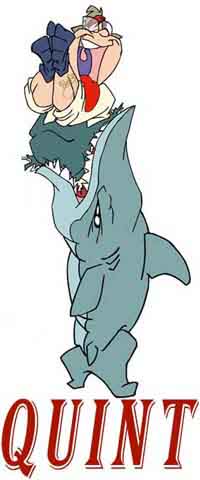Ahoy, squirts! Quint here, recovering from BNAT, with an interview I did last week with artist Alan Lee. Alan Lee's vision of J.R.R. Tolkien's LORD OF THE RINGS was the jumping off point for Peter Jackson in creating the films. Jackson has said that he approached the films not trying to best every fan of the books' imagination, he just wanted to top Alan Lee's and John Howe's visions. So, naturally, Jackson hired both Lee and Howe to be the lead production designers of the LOTR films. Lee is widely regarded as being the best Tolkien illustrator, the one who gets his world the most. Not that Lee himself would proclaim himself King of Tolkien. He's far too humble for that.
Anyway, here's the chat we did in order to promote the 50th Anniversary of the publication of THE LORD OF THE RINGS. Lee was touring the US and ending up in London (at Forbidden Planet) with his artwork and signing copies of the ART OF books and various releases of the LORD OF THE RINGS. He was in New York when we did this phoner.
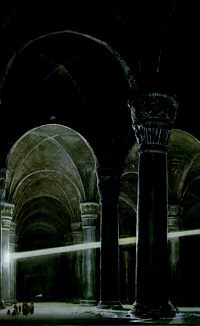
QUINT: So, how's the tour been so far?

QUINT: So, how's the tour been so far?
ALAN LEE: It's been great. The book's a wonder. The books are lovely, (been to) beautiful book stores and they've publicized it well. Lots of people there.
QUINT: And this is the all-in-one LORD OF THE RINGS 50th Anniversary book?
ALAN LEE: Yeah, they had that one and the (Alan Lee) 3 volume edition. They just got in the new Art of the Lord of the Rings book, which is the best of the art that was in the three previous books for each of the movies, plus stuff that hadn't been seen before. I think it's the nicest looking of the Art Of books so far.
It was a great event yesterday afternoon in Philidelphia. It was very well attended.
QUINT: Yeah? Were you mobbed by people in costume?
ALAN LEE: (laughs) No, no people in costume.
QUINT: Ah, you must be getting the more high culture literature types.
ALAN LEE: I don't know. I think the weather's good enough, is it, for dressing up as elves.
QUINT: That's true. It's a little too cold.
ALAN LEE: Yeah.
QUINT: I have the 3 volume Alan Lee LOTR box set and flipping through all three books it seemed that FELLOWSHIP had more of your paintings than the other two volumes. Did FELLOWSHIP grab you more than the other two or does it just lend itself more to a visual adaption?
ALAN LEE: Well, it was all done as one edition, originally. The whole book was done as one. It might appear that way because I think there are more environments you go through in FELLOWSHIP OF THE RING. More variety.
QUINT: You seem to get and relish the elf culture and architecture in the art you've done for the books...
ALAN LEE: Yeah, it almost feels like that's almost the soul of Middle Earth, the kingdoms of Lothlorien and Rivendell... they kind of have the essence of Middle Earth. It connects up with the film really. I always felt like, in the films, that was an area that was very important to get right and it was the area we could go most disasterously wrong. If the elves had ended up looking bad or the sets didn't work, it would have undermined the whole thing. Fortunately, I think we did OK.
QUINT: Was it pretty intimidating to shoulder so much of the responsibility of what the films would look like? I mean, it was pretty much you and John Howe that Peter hired to create a way to bring Tolkien's vision to something doable for the films.
ALAN LEE: Yeah, but there was also a great designing department at Weta Workshop as well, but they were concentrating more on the creatures and the armor and other aspects...
QUINT: Well, if you just look at some of the work you did in the 3 volume set, there are pieces that could almost be freeze-frames from the movies.
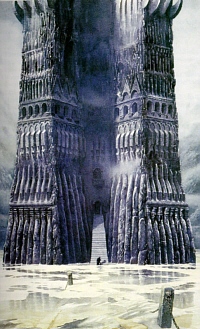
ALAN LEE: There were a few pictures in the edition that Peter thought was just exactly what he wanted for the film, like Orthanc. And there's that scene with Sam and Frodo and Gollum. Peter just liked that moment and wanted to recreate it. But John's work as well... John's depiction of Barad-dur is pretty much how Peter wanted. But that left an awful amount to actually create for the movies, as well. I spent 6 years down there working on them.
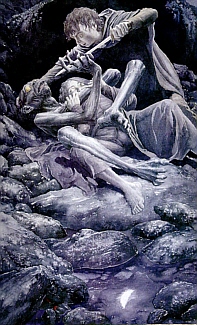
QUINT: One of my favorite places in the world. I spent a couple months there last year and just recently went down for a month and visited KONG. Wellington is an amazing place.
ALAN LEE: Yeah, it's amazing. Did you get down to the South Island?
QUINT: You know, I've been to New Zealand 3 times and have yet to make it to the South Island. When I was out there in October, I was supposed to arrange a visit to CHRONICLES OF NARNIA, which ended up falling through, but the whole time I was there the visit date was up in the air, so we couldn't arrange a 3 or 4 day trip down to Christchurch or Queenstown in case I got the call to visit NARNIA. I'm looking forward to rectifying that on the next trip to New Zealand.
ALAN LEE: I'm very curious as to how that's working out. What's the news on THE CHRONICLES OF NARNIA?
[At this point I tell Lee some super-awesome confidential information, which I'm not at liberty to share... but you can check out some of what we talked about at that Exclusive bit of behind-the-scenes of NARNIA here]
QUINT: I'm curious about how different your job is when working as a concept designer on a film as opposed to illustrating a novel.
ALAN LEE: It's very different because when I'm illustrating a novel I'm very much being respectful to the words and also steering clear of areas that the author has really described in great detail because there's the danger that you'll undermine what he's doing or you'll be kinda reproducing it. I tend to work in the more kind of shadowy areas, the areas that are kind of glossed over a little bit, in the hopes that by adding color and atmosphere, by building that up in the reader's imaginations, that will kind of spread an influence throughout and the whole experience reading the book will be a bit richer.
But in film, of course, you can't avoid those dramatic moments. That's what it's all about, so you have to be quite confident and just go for it, trust that what you're doing is going to coincide with the way the audience has already imagined the world, if they've read the books before. Generally, the reaction I've had is that people say, "It's exactly how I imagined it," which is good.
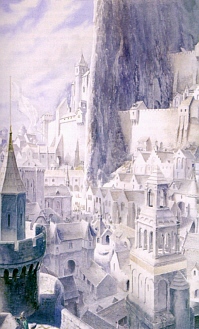
QUINT: What element from the books was the hardest for you to crack when doing the concept design work on the LOTR films?
ALAN LEE: There were a few areas that were a bit tricky. I think Lothlorien, for the reasons I said earlier, the fact that it's just so crucial to get that elvish stuff right. That went through a lot of different variations on that to get the right look. Then there are other areas that were just so easy, in a way. They involved a lot of hard work, but felt like you were on the right track right from the beginning. Like the whole Rohan culture and Edoras and the Golden Hall and all that stuff. Everything just seemed to fall into place really well.
By that stage in the movie everyone was really up to speed and working well. It just sort of flowed out. They were fantastic sets to visit, the exterior set in the South Island and also the interior sets that were built in Wellington. You just really felt that you were stepping back a thousand years in time.
QUINT: Funny, watching the movies the Rohan culture really stands out to me. The design is much warmer than the Gondor culture.
ALAN LEE: Yeah, it's very vital, isn't it? These guys riding around this fantastic landscape, with this amazing armor, on these wonderful horses and everything just tied in together really well.
QUINT: And Howard Shore gave them such an amazing theme. Out of all the majore cultures in the film, the Rohans got the best, heroic triumphant music.
ALAN LEE: I think the score throughout the movies is just fantastic. It's a really important part of creating the right atmosphere and keeping everyone interested. It's so often I feel that scores in movies fall a bit flat.
QUINT: Well, you look at SPIDER-MAN and X-MEN, movies I really like, but they're missing that SUPERMAN music. SPIDER-MAN's kinda got a recognizable theme, but it's very low key and untriumphant. To me, Howard Shore's LOTR music is the only thing that comes close to the classic, Old Hollywood film score that's been out in quite a long time.
ALAN LEE: Yes. It's symphonic, a work of art in its own right.
QUINT: What was your day to day like when LORD OF THE RINGS was in production?
ALAN LEE: Well, if they were shooting in the studios, that meant that catering was up and I'd get an early breakfast. (laughs) I'd be spending a lot of time drawing, working very long hours. I mean, really working 'til 9 or 10 most nights. I'd often have a que of people actually kind of needing stuff from me. We had a couple props designers working with us and they'd come up and show drawings for a table and chairs, stuff like that. So, I'd give some feedback or do a quick sketch for them.
Sculptors and construction crews would come in and need a little bit of extra information. It just seemed that there was no end to the amount of detail that you could actually put into these films. It was just intense, very very busy. Working with Grant Major and Dan Hennah and visiting the sets as they were being built...

QUINT: Was that surreal to you to draw a room and two weeks later step into it?
ALAN LEE: Yeah. Sometimes a couple of days later. (laughs) By the time we were kind of reaching the end of the production there were sets where there might have been a script change or a set was brought forward a few weeks because of an actor's availability. You've got actually turn it around in a few days. I'd do a drawing, show it Peter, get an approval and it goes into production.
Some of the most remarkable sets were green sets, where you have an area of forrest or something. Very often that would be done overnight because the greens would need to stay fresh for shooting. There were quite a few sets where you almost didn't have time to draw it (laughs). You just do a very quick sketch and go down to help arrange the trees and the plants. It was a very exciting, very vital process and really exhausting. But the energy of the production and Peter's enthusiasm and dedication, attention to detail, kept the whole thing on track.
QUINT: When I was doing a little research for this interview I found out that you worked on a film that I love... it actually scared the hell out of me as a kid, but could you talk a little about what you did on LEGEND?
ALAN LEE: Well, I only worked on preproduction. Ridley Scott was finishing off BLADE RUNNER, he was cutting that and he was also working on this idea for a fairy tale. He had a writer, William Hjortsberg, the author, and he got me to come in and sit in an office in Pinewood and just churn out drawings, just ideas really for what could be in the movie. He was developing the script along side developing ideas for creatures.
QUINT: Did you work on anything that ended up directly used in the final product?
ALAN LEE: Yeah, there are scenes that are similar, concepts that are similar, characters that are similar. For example, the entrance to Darkness' kingdom, that kind of tree with a horn imbedded in it. That was very much taken from my drawings. And elements of the goblins.
QUINT: See, that surprises me a bit. For that movie, if I had known someone worked on the concept art for LEGEND and LOTR I would have guessed it was John Howe because it's so dark and you worked primarily on the lighter aspects of the LORD OF THE RINGS movies.
ALAN LEE: Yeah, it is pretty dark, but you know, my involvement didn't really last all that long. I came back and had a quick look at how things were going when they were actually shooting, but I didn't really get involved with it.
QUINT: Rob Bottin's make-up work is amazing in that film. Tim Curry was fantastic as Darkness.
ALAN LEE: Yeah, that's a stunning piece. Rob Bottin's work... I did a couple of little drawings, but they weren't really like what he finally did.
QUINT: Of Darkness?
ALAN LEE: Yeah.
QUINT: What were yours like?
ALAN LEE: It had more of an animal head, more devilish... Um, well... Actually, I don't know (laughs)... I mean, more of a tradition depiction of a devil.
QUINT: Not with the big longhorn horns.
ALAN LEE: Yeah, nothing as dramatic as Rob put.
QUINT: I didn't see you around the KONG set, but I hear you were worked on that a little bit.
ALAN LEE: Just as we were finishing off LORD OF THE RINGS, in April this year when he just really finished with it. I started doing a little bit of work on KONG and then came back to England and did a few more sketches. The idea is I just concentrate on one small part and then Peter asked me to come out for a couple of months and work on one set. It's actually the Skull Island native village set, one of the main features of the Skull Island part of the movie.
I came out and did a model of the set and a few drawings. I was only out there for a couple of months.

QUINT: You mean the area where the Venture comes in... or more the gate?
ALAN LEE: Yeah, no... It's more the area around the wall and the gate. I didn't actually design the wall itself, that comes from Gus Hunter's work. Yeah, so I just did a bit of work, then came back and got on to some more book work, which is what I've been trying to get back to for a few years.
QUINT: So, do you prefer doing that to concept design work?
ALAN LEE: I like both, actually. I'd love to be able to switch from one to the other. They're just so different. The great thing about working on a movie is you're collaborating with a lot of very talented, really nice people, so it's a great atmosphere. It's very exciting and things happen quickly, whereas working on a book is more of a lonely endeavor. But I love books and I don't want to let that go.
QUINT: What's next for you, then?
ALAN LEE: I'm actually doing a book at the moment, which is a LORD OF THE RINGS sketch book. I've kept sketch books throughout my whole career, I mean really since I was a student. So, you got this kind of underlying record of all the work and all the thought that goes into the finished drawing that would normally never get seen. I wanted to do a book that was just about the sketches, really, and it would look and feel as much like a sketch book as I could make it, that when you look the pages you'll feel like you're looking at real pencil drawings.
QUINT: Well, I love your pencil work, man. I'd say I prefer it to the paintings you've done.
ALAN LEE: Well, it's so direct, you know? It's going straight from the mind to the paper. You're not having to worry about various processes to kind of pass it through before you get a finished vision. It's really just about communicating what you need to communicate to whoever is going to see the sketch. You're not really thinking about producing a nice drawing, that's kind of the last thing on your mind. It's just kind of "What does this object look like?" and because of that they do have a special quality.
QUINT: Do you have a street date at all for this sketch book?
ALAN LEE: It'll be sometime towards the end of next year.
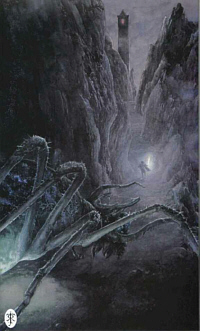
There you have it, squirts! I, for one, am very excited to see what Alan Lee has in store for us with this sketch book. The Gandalf he drew for me in my sketchbook during my time on the ROTK set is amazing. I wasn't bullshitting when I said I love his pencil work.
Hope you liked the interview. I know you're busy watching the RETURN OF THE KING: EXTENDED EDITION and all the goodies on that DVD, so I'll let you get back to that. Keep your eyes on the site, squirts! I got some goodies that look to hit before the new year you may be interested in. Can't say any more than that at this time, but trust me... it'll be something really cool. 'Til then, this is Quint bidding you all a fond farewell and adieu.
-Quint
